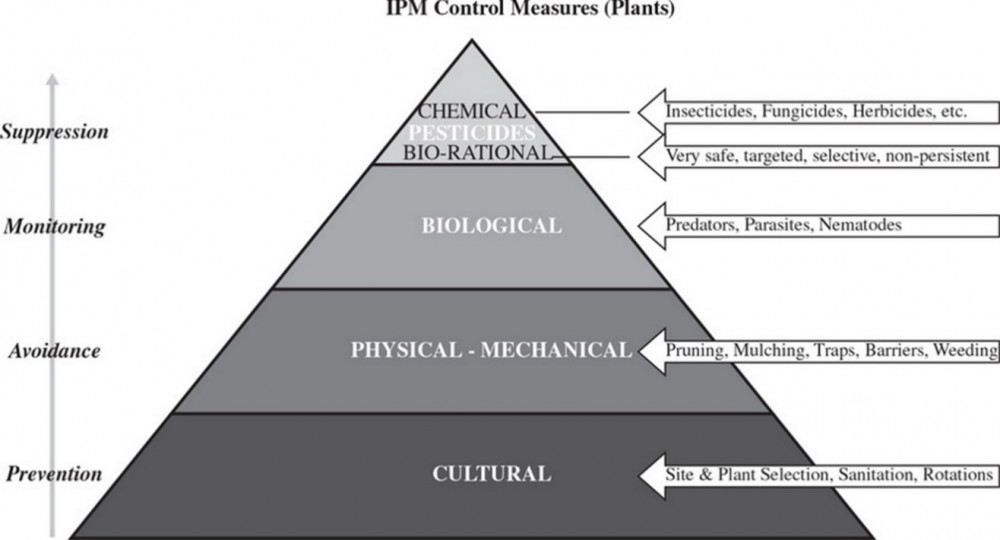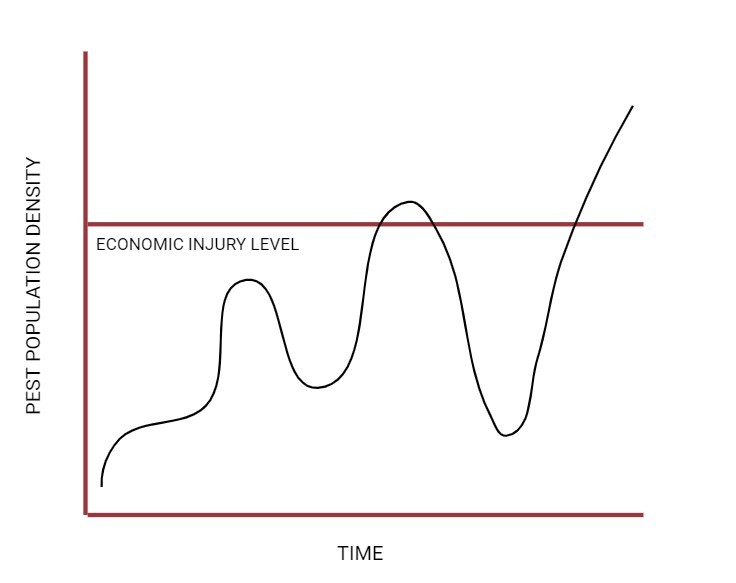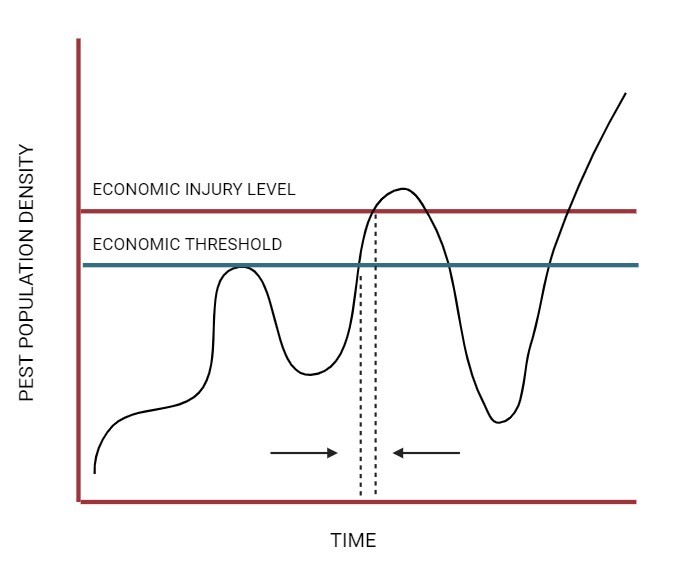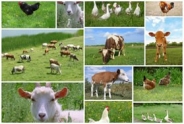Integrated Pest Management
Katelyn Miller, Field Crops and Forage Specialist
Southwest New York Dairy, Livestock and Field Crops Program
According to the National IPM Network, Integrated Pest Management (IPM) is a sustainable approach to managing pests by combining biological, cultural, physical, and chemical tools. These tools should be used in a way to minimize economic, health and environmental risks. Our main goal is to prevent pests from reaching economically damaging levels. Let's review the various management tools in our IPM toolbox.
Cultural practices help prevent a pest outbreak from happening. Some management tactics include crop rotation, seeding rates, and equipment sanitation. Physical (also known as mechanical) practices involve physically managing a pest. Examples of different management practices include hand weeding, mowing, and placing traps. Cultural and physical management practices focus on preventing pest issues from developing. Biological control involves the use of beneficial insects to control a pest. For example, lady beetles serve as a natural predator to soybean aphids. Chemical control involves utilizing different pesticides. Most commonly in field crops, that includes insecticides, fungicides, and herbicides. Relying on chemical control rarely succeeds in controlling pests.

There are various steps to an IPM plan. They include preparation, identification, sampling, analysis, management alternatives, implementation, and re-evaluation. They all serve an important role in a complete IPM plan.
Preparation: Before anything else, it's important to understand what information you might need. Your Cornell Cooperative Extension staff is always happy to help provide information. Research crop development, understand field history, and learn different sampling methods for different pests.
Identification: Correct identification is the most important step in controlling a field problem. An incorrect diagnosis leads to mismanagement. After identifying the pest, learn about its biology. This will help you understand pest damage signs and susceptible crop stages.
Sampling: Sampling takes the guesswork out of pest control by quantifying the problem. Make sure to use the proper sampling method(s) for the right pest. Using the right method will allow you to accurately quantify the damage.
- Insect sampling can involve utilizing sweep nets or variations of traps (sticky, pheromone). Scouting will look different depending on if the insects are mobile or immobile.
- Disease sampling takes place throughout most of the growing season. This is because each disease is favored by different environmental conditions. Diseases can be present in patterns or randomly distributed.
- Weed sampling should be done in the spring and fall to gather information about the different species present. We want to document weed type rather than the count of each species.
Analysis: This is your chance to decide how bad the problem really is. Weigh economic, environmental, and time concerns when making the decision to control. Use thresholds to make the decision to spray. They allow us to avoid unnecessary applications, reduce the risk of environmental impacts, avoid risk to non-target organisms and reduce the risk of pesticide resistance.
- The Economic Injury Level (EIL) is when the cost of pest control equals savings from crop damage avoided. This is also known as the break-even point.
- Economic Thresholds (ET) are when the pest density is at a point at which control action must be taken to avoid economic loss. These are lower than the Economic Injury Level to give time to discover there is a problem and act.
- For example, the ET for soybean aphids is 250 aphids/plant, but the EIL is 670 aphids/plant. If we waited to treat until the aphid populations reached 670 aphids, we would experience economic loss. With that, it's also not economical to treat before we reach the ET for the pest.


Management Alternatives: When action is needed, a strategy should be chosen that fits with your short and long-term goals, labor, capital, equipment, and finances. Look at the costs, benefits, and risks of different management strategies.
Implementation: Now it's time to implement your chosen strategy or strategies. Make sure to implement any changes at the right time for the best control.
Re-evaluation: Finally, we must evaluate our management strategies. Did everything go the way it was supposed to? Did the pest get controlled? Looking back at what you did enables you to learn from experience and find ways to improve management skills in the future.

It's important to remember that IPM is a philosophy that identifies and corrects a problem. There is no "cure-all" and eradication is seldom necessary. Our goal is to prevent pests from reaching economically damaging levels with the least amount of risk. In general, the goal is to integrate a variety of management tactics that best fit your situation. For more information about IPM, contact Katelyn Miller at 716-640-2047 or km753@cornell.edu.
Upcoming Events
Crops, Cows & Critters - Southwest New York Dairy, Livestock & Field Crops Newsletter Sponsorship
December 19, 2025
January 30, 2026
Our two forms of publications feature research-based and timely information from our four specialists, listed to the right, along with local event notifications and Cornell University outreach. This information is provided to participants who range from dairy, livestock, and field crops producers to agricultural suppliers and consultants.
Weekly Email Update: Shared with 625+ households who have signed up with our program.
Monthly Paper Mailer: To reach our stakeholders and farmers who lack internet access, we send out a monthly mailer where your company's logo and contact information would be featured with a mailing list of 330+ households.
If you sponsor our weekly and monthly publications you reach approximately 955 households.
Visit our website to view our newsletters!
2025 Cornell Food Beverage & Animal Feed Manufacturer Survey
December 19, 2025
Industry and Educational Advocates for New York State's Food, Beverage, and Animal Feed Manufacturing industries:
As you know, NYS has a diverse food and beverage manufacturing industry, in both the types of industries that exist and the wide distribution of firms by scale. Many manufacturing firms have strong backward linkages to agricultural production sectors in the state that support both farm-level and downstream food industry firms and consumers. In collaboration with the New York State Department of Agriculture and Markets, a team from Cornell University's Charles H. Dyson School of Applied Economics and Management has recently rolled out the 2025 New York State Food, Beverage, and Animal Feed Manufacturer Survey. The industry will benefit from an updated assessment of the industry that informs private and public investments and opportunities to support firm growth and improved profitability.
Boots in the Barn: Cornell Dairy Research Updates
January 13, 2026
January 20, 2026
January 27, 2026
February 3, 2026
February 10, 2026
February 17, 2026
February 24, 2026
Join us for some or all!
Announcements
No announcements at this time.





